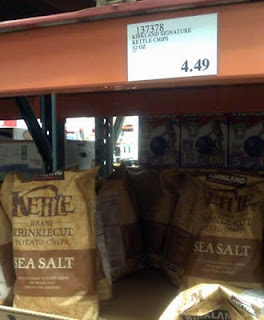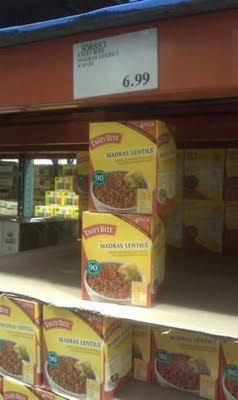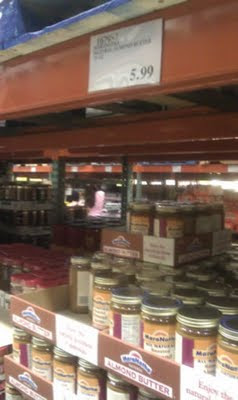Costco Gluten-Free Bargains, Deals, and Money-Saving Products
This is a follow-on to my prior Gluten-Free Blog entry about Gluten-Free Food / Product Bargains at Costco in 2011. Fact is, I am finding more and more gluten-free diet items at CostCo, and saving money in the process (compared to regular grocery-store prices or Whole Foods and other alternatives).
The
savings add up when purchasing some of our regularly-used gluten-free items from CostCo, and that money-savings is definitely covering the cost of our annual membership. As mentioned in my prior blog, I have compared the bulk-pricing of some gluten-free diet items to the non-bulk-pricing counterparts in normal grocery stores, and I am seeing saving of well over 50% on the same item in quite a few cases! Even where the savings are perhaps "only" 20-25%, in total that adds up to a LOT of money saved!
Gluten-Free Multi-Grain Chips : Bargain Priced Big Bag
 |
| Multigrain Chips at Costco : gluten-free |
If you like the
"Foods Should Taste Good" (brand) products, Costco has a few that are much better priced than elsewhere. This
large 24-ounce bag of their Multi-Grain Tortilla Chips is currently $6.29. That sure beats the comparable per-ounce price elsewhere if you like these. This variety is gluten-free even as it includes
oats in the formula (along with soy flour, flax, rice, quinoa, corn, and sesame).
Costco also carries their Sweet-Potato tortilla-chips (ingredients: Stone ground Corn, Oil, Sweet Potato, Corn Bran, Cane juice, salt) for a similar price.
Gluten-Free Sweetener : Agave Nectar in Bulk
 |
| Agave Nectar at Costco |
Costco carries the
"Wholesome Sweeteners" (brand) organic blue agave in a 2-pack: (2) 23.5-ounce containers of Agave nectar for $7.49. From what I have compared to elsewhere, this is as much as a 50% savings on something that has a rather long shelf-life and can be used for a variety of sweetening purposes. Although I use the PureVia (stevia) most of the time (also acquired at CostCo: see prior blog for pricing), I use the agave nectar on occasion when I convert my plain yogurt into other flavors and variations (using frozen berries quite often or even cocoa, cinnamon, or vanilla).
Gluten-Free Health-Food: Dried Plums for Healthy Snacks
 |
| Sunsweet Dried Plums |
Yes,
DRIED PLUMS (i.e., the new branding of what used to be "prunes")! Well, I can tell you with certainty that
these are very tasty dried plums, and they are quite a deal at $6.49 for a 3.5-pound bag of Sunsweet California-grown pitted prunes. They are
sweet and delicious while having just the right level of moistness. Sold as a healthy treat that is high in antioxidants and fiber (3grams per 5 plums), they also have a nice dose of heart-healthy potassium (290mg per 5-plum serving) with only 100 calories for that same quantity. Definitely recommended.
Gluten-Free Snack: Bhuja (Indian)
 |
| Indian-Inspired flavorful gluten-free snack mix |
This was a recent find:
Majans (brand) Bhuja original mix ($7.95 for 800g; i.e., about 2#) all natural snack that has a savory and aromatic blend of Indian spices (fennel, chillies, tumeric,cumin, corriander, paprika) teamed up with some crunchy "noodles" (made from yellow peas, chick peas, rice, potato, tapioca, and sesame seeds) and also some peanuts, raisins, and dried green peas.
The product is actually
made in Australia and clearly marked gluten-free on the label. This snack-food is a welcome change from some more mainstream snacks, and
I find the combination of herbs and spices pleasing. There is 171mg sodium per 25g serving, and you get 5grams of protein (thanks to that pea-flour) and 2g fiber per serving also. This is one of the first such products I have found anywhere that was clearly labeled GF, and it is priced competitively to other non-GF varieties I have seen at Indian markets and similar.
Gluten-Free Potato Chips
 |
| Gluten-Free Kettle Potato Chips in Bulk : 2# for $4.49!! |
Gluten-Free Drink: Low-Sodium V8
Costco carries
Low-Sodium V8 vegetable-juice in cases (28-count) for $13.99, or 50cents per 11.5-ounce can, which is not too shabby for a healthier alternative to sweetened soda or similar options. This vegetable juice does have a bit of added sugar that I would prefer they left out (as the sugars are pushed to 12g per can). There is a reasonable sodium level (200 mg) and a super-high potassium level to help counter any sodium (1180mg; boosted by their addition of potassium-chloride), and even 3grams of protein and 3grams of fiber (neither of which you will get from a standard soda!). In addition, Costco had a nice big COUPON for these recently where I saved multiple-dollars-per-case! Nice!
GF Non-Fat Yogurt: Fage Total 0% on the Cheap
 |
| Fage Total Zero-Percent-Fat Gluten-Free Yogurt (Kilo) |
First of all,
this is some really fantastic non-fat Greek yogurt! I mean to do a full "review" of this product, but in the mean-time, you can at least be aware of the
Costco bargain price of $4.99 for 1-Kilo (33.8-ounce) Containers : a full 20-25% less than the best grocery-price I have found. This yogurt has a
great thick and creamy consistency and makes a perfect start to many other self-created flavors of yogurt, and is also works well as a sour-cream alternative and more.
This Fage Total yogurt is
loaded with protein too! A 1-cup serving (8-ounces) has
only 130 calories, but yet packs a whopping 23-grams of protein into that serving; and, there are only 9-grams of carbs to accompany your mega-protein dose. This is a very
diabetic-friendly product (or great for anyone watching their glycemic-index or blood-sugar), and if you make flavored yogurts of your own (starting with this product) and use something like Stevia for sweetening your creations, you can keep the sugar-levels super-low while getting 1/2 of your daily protein in one serving.
I have found this non-fat yogurt
great for weight-loss and trimming some fat from my diet while keeping protein levels up (during weight-lifting and exercise too); the result has been a noticable reduction in overall body-fat levels and increased "toning" (note: again,
I coupled this with *exercise* and weight-lifting... it is not a "magic" fat-loss remedy. sorry). You may get some benefit even without much workout effort if you find the yogurt as satisfying (to your appetite) as I do: it seems to "fill me up" for quite a while with low calories, and I presume the high-protein level helps with that. And, when combined with exercise, this stuff is just fantastic.
Gluten-Free Hummus in Bulk
 |
| Hummus and Lentil Chips : all gluten-free! |
Sabra (brand) Hummus in large 1-Quart (yes, a LOT of hummus!) containers for only $5.99! I have seen tiny little 8-ounce containers of the same brand of hummus at regional grocery stores for nearly that same price... and, as much as I like hummus, I definitely can go through 4-times the hummus for roughly the same price. I love this stuff on tortilla chips, celery-sticks, carrots, and lentil-chips... which brings me to...
Mediterranean Snacks brand of cucumber-dill (flavor)
Baked Lentil Chips: $5.89 for a big one-pound bag of these fantastic chips when they were recently being sold by Costco this summer. But, lately I have not seen a new supply come in to replace the last batch a few weeks ago. I HOPE they get them back in stock because they are wonderful tasting (perhaps slightly too much sodium, but otherwise good), low-calorie, and high in fiber.
A one-pound bag is rather large (in size) because the chips are
very light and super crunchy (great texture, and they hold up to dipping in hummus, etc!). Being bean-flour-based (lentil, garbanzo, and adzuki beans) these crunchy gluten-free snack chips packed 3grams of fiber and 4grams of protein into a 110-calorie one-ounce serving (and, a serving is a full 22 chips, not just a few chips); and, 10% of your iron, plus only 3-grams of fat per serving! The chips are made in USA and clearly labeled gluten-free (right on the front cover). Please Costco, GET MORE of these! :)
Cheap Cinnamon
I have been purchasing Costco's own brand of Ground Cinnamon which is incredibly reasonable at
a mere $2.65 for 10.7-ounces! Seriously! That is CHEAP for this wonderful Saigon Cinnamon, and I use it as a type of "flour" in my baking (including my frequent pancakes), so this saves me a fortune. I have no idea why cinnamon varies so much in price, but I have seen (in grocery stores) the same thing cost as much per ounce as this entire container costs.
Savings: up to 90%! And, the printed expiration-dates are at least 2-years out, so there is no chance I will not use ALL of a container in time (in fact, I go through one every few months).
Gluten-Free Body-Wash
Yes, you read correct: body-wash that is labeled gluten-free. I am rather "set in my ways" when it comes to the products I use for soaps, shampoos, and such, but when I saw
Costco's own Kirkland (brand) of citrus body wash with the GF-labeling, curiosity got the best of me. I unscrewed a cap at the store to see what it smelled like...it has a pleasing scent of orange and citrus. So, I figured why not... and got some.
The Gluten-Free Body-Wash comes in a dual-container package: i.e.,
(2) 27-ouce containers for $9.99. That is a lot of body wash. I really do not know how well the price compares since I do not know what to compare it to, but it seemed reasonable for just under 1/2-gallon of the product, and it has been lasting quite a while. I definitely like the noticeable smell of oranges, and it seems to do what it is supposed to: it cleans just fine.
Gluten-Free Fruits and Vegetables
Fresh fruit and veggies: although I did not list specific examples here, there are quite a few great money-saving deals on fresh vegetables (lettuce, carrots, celery, asparagus, spinach, tomatoes, etc) and fruits (raspberries, blackberries, cherries, strawberries, watermelon, apples, cantaloupe, honeydew, figs, bananas, oranges, grapefruit, etc) at Costco, and of course these are all great gluten-free diet options.
The
prices generally beat the grocery store (substantially in many cases), but the prices vary considerably with the seasons and availability just like at any other store, so I did not provide specific cost-examples. I am rather sure that we save enough *just* on the fresh fruits and veggies every year at Costco to pay for the membership; that should give you a feel for what the savings can add up to.
More Gluten-Free Costco Bargains to Come...
This is the second installment of the Costco gluten-free products discussion. I plan to do more, as there are a lot of GF deals to still enumerate here (and products I really like). Stay tuned for the next list of bargains. I hope you have a Costco location near you so you too
save you money on gluten-free products. Also, there are more items listed on my prior blog here:
Gluten-Free Food / Product Bargains at Costco in 2011.
Continue to read this
Gluten-Free Blog for all sorts of gluten-free recipes, product-reviews, and related information. In addition, visit my
Gluten-Free Recipes Site where many of the recipes I have featured on this blog are available.















